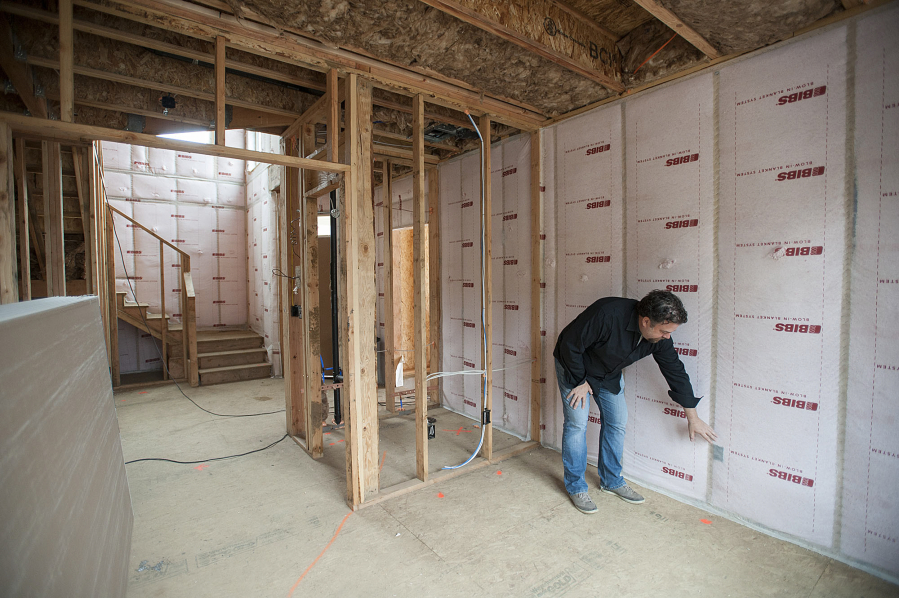BRUSH PRAIRIE — Urban Oaks, a subdivision near Prairie High School, springs out from the fields. Its more than 100 homes are new, sleek and modern; but their most important trait may be that they are being purchased.
They are energy-efficient homes. Most don’t show the telltale solar panels on the roof, but they are built airtight and are primed for all sorts of energy savings. Developer Troy Johns said it only seemed recently that buyers started showing interest in these features.
“When we started building these eight years ago, it was kind of a new concept and people were like ‘Eh, all right,’ ” said Johns, who founded Urban NW Homes in 2008. “Now, 30 to 40 percent of our homebuyers are coming for these types of houses.”
Homes are changing in Clark County, trending toward more energy efficiency and automation. Ask a homebuilder about these trends and the conversation sounds like it could take place at a car dealership.
“It’s like the (Toyota) Prius versus a Corolla,” said Tony Marnella, whose company Marnella Homes builds energy-efficient homes. “The Prius is probably more expensive than the Corolla, but it’s no matter to some people because that’s what they want.”
Recent development
Homes at Urban Oaks vary in size and style. That’s mostly a manifestation of Johns’ philosophy that neighborhoods be inclusive to different classes, so the homes there range in price more than usual, he said.
They all have a few things in common, though. Each home can be easily outfitted with solar panels and become “net-zero,” meaning it generates as much electricity as it consumes.
It’s the sort of feature that Vancouver resident Peggy Ellis said she had hoped to find in a home for decades, but only now has been able to actually purchase. Ellis and her husband, Lyle Bush, are building a net-zero home in Felida through Urban NW Homes.
“There’s the expression ‘It takes green to be green.’ I do think there’s some truth to that,” she said. But not as much as a few years ago. Today, she said, “the technology is there and it doesn’t cost much more to do it.”
Part of the price drop is a byproduct of the changing home market. Mike Selig, a program development manager for Clark County Building Safety, said building codes have been updated across the country, requiring homes to meet a tighter standard.
“It was a challenge for some” builders, he said. “Others saw it as the new way they were going to be building homes.”
With builders pushed to adopt newer building codes, there are also more subcontractors capable of building energy-efficient homes. Labor costs that used to be marked up are now dropping, Johns said.
“There are ways that we frame houses that, when we started doing this eight years ago, it was brand new and nobody had done it before,” he said. “Eight years ago, it cost us (an extra) $10,000 per house. Now the costs are way down.”
In 2010, Clark County officially adopted the National Green Building Standard as its preferred certifier of energy-efficient homes. Though it’s voluntary to get certified, the NGBS reports that just nine homes were certified between 2010 and 2014; but between 2015 and today, 152 homes have been certified, with another 71 in the process.
Where’s the green?
Though these homes are becoming cheaper, they are still more expensive than homes that are built at the standard building code.
To build for energy efficiency, builders spend extra on features like blown-in insulation that help seal the air currents in the home. They take added measures to keep moisture out. They use less wood, too, so the homes need more engineering.
Marnella said he hoped prospective buyers weigh the price of an energy-efficient home against the money they will save on a utility bill.
“If someone’s trying to pay anywhere from 3 to 5 percent more, you’ve got to be able to make that return on investment within three to five years,” he said. “The national consumer research shows they are willing to spend extra if there’s an ROI in a shorter period of time.”
But even if they are more energy conscious, said Terry Wollam, managing broker at ReMax Equity Group in Vancouver, he’s not seeing a sea change in the habits of would-be homebuyers. A lot of them still prefer the cheaper house built to the standard building code, he said.
“The broad brush stroke is: Is it important to them? Yes. Are they willing to pay for it? Not really,” he said. “There are a lot of people that buy homes built by national builders that meet building codes, and they’re not doing anything beyond building homes.”
Big national builders are offering more energy-efficient homes than they used to, however. Miami-based Lennar Homes, the second-largest homebuilder in the United States, has only had a presence in Clark County since 2009. Chris Kincaid, its vice president of marketing, said Lennar is constructing more energy-efficient homes here because governments and consumers both want it.
“The green home demand is full-on and it’s not going back,” he said. “Part of that reason is consumer demand, and part of that reason is code-driven,” he said. “It’s resonating well with the customer.”
Electrical backbone
Another new concept gaining a toehold is automation. While futurists predict drone landing pads will someday come with our high-rise apartments, today’s technology is already playing a role in the housing market.
For example, smart thermostats, such as Nest, are becoming more and more in demand, said Tony Curtis, who owns Current Home Technologies in Vancouver. The device studies its owners and varies its heating and cooling based on their habits.
A big seller for Curtis are moisture sensors. The quarter-sized devices, he said, can help a homeowner detect black mold before it festers or learn about a leaky pipe while away. The sensors are bundled with security cameras that can be used on smartphones.
“If the moisture sensor in the laundry room was triggered, on the app you flip over to a separate screen in the house and see if you’ve got water flowing,” he said. “Then you can call your neighbor.”
Curtis said this has always been talked about in his industry.
“We were talking about this in the ’90s,” he said. “We were told refrigerators were going to do all the grocery shopping in the future.”
To that end, Johns, the head of Urban NW Homes, said the future is already here.
Homes at Urban Oaks come with a “backbone,” — high-speed wiring to connect appliances to the internet. He said he used to only have to worry about getting water to the refrigerators; now he has to get them fiber optics.
Correction: A previous version misidentified Tony Curtis’ company. It is called Current Home Technologies.




